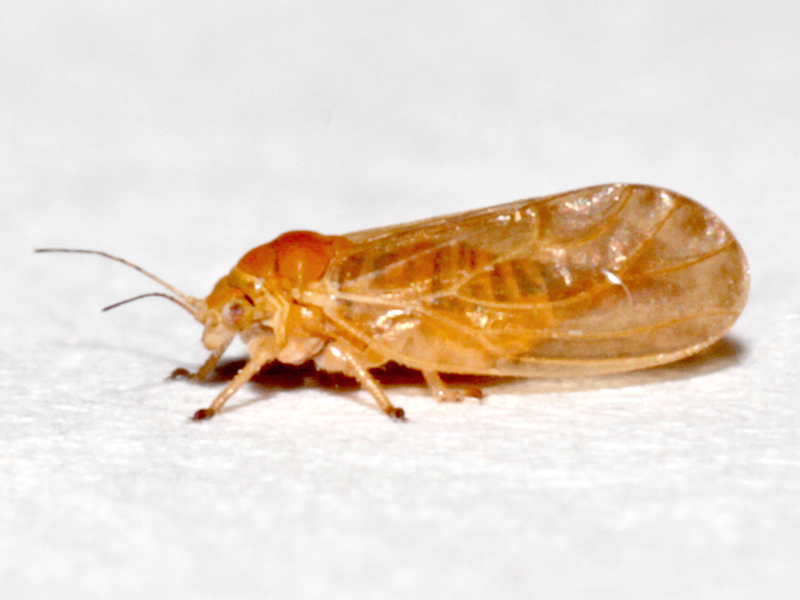Chamaepsylla hartigi
Previously known as Psylla hartigi but now placed in the genus Chamaepsylla.
This species seems to be one of the commonest psyllids to appear in my moth trap. It is quite unlike any other species that I've encountered so far, but needs to be separated carefully from others I haven't seen, especially Chamaepsylla pruni.
Females are relatively easy to tell from pruni as the terminalia is much longer
, North Elmham, 26-Jul-20 (A) (1).jpg)
, North Elmham, 26-Jul-20 (A) (2).jpg)
female Chamaepsylla hartigi showing terminalia, North Elmham (Norfolk, UK), 26th July 2021
Males seem to me to be a little trickier - the paramere is supposed to about three quarters of the length of the proctiger (half in pruni) but this doesn't seem to be very consistent to me. I'm not sure how easy it is to see pruni's apical denticle on the paramere. But all the male (and female I think) hartigi I've examined have had obvious pale hairs on the abdominal sternites, whereas these are supposed to be largely missing on pruni.
, North Elmham, 10-Jul-21 (B) (1).jpg)
, North Elmham, 10-Jul-21 (B) (2).jpg)
male Chamaepsylla hartigi showing genitalia, North Elmham (Norfolk, UK), 10th July 2021
These three came to light on the same night and I thought they might turn out to be something new that I'd not seen before. On all three the wing membrane was noticeably darker alongside the wing veins than in the centre of the cells which I don't recall seeing in hartigi before (though from the photos it looks like it may have been the case on some, but not all, of the others on this page). Anyway, all three keyed to hartigi.
, North Elmham, 23-Jun-23 (A) (1).jpg)
, North Elmham, 23-Jun-23 (A) (3).jpg)
, North Elmham, 23-Jun-23 (A) (4).jpg)
, North Elmham, 23-Jun-23 (B) (2).jpg)
, North Elmham, 23-Jun-23 (B) (3).jpg)
, North Elmham, 23-Jun-23 (C) (1).jpg)
, North Elmham, 23-Jun-23 (C) (2).jpg)
, North Elmham, 23-Jun-23 (C) (3).jpg)
, North Elmham, 23-Jun-23 (C) (4).jpg)
3x male Chamaepsylla hartigi showing genitalia and hairs on sternites for all 3 and forewing for third, North Elmham (Norfolk, UK), 23rd June 2023
, North Elmham, 24-Jun-21 (B) (1).jpg)
, North Elmham, 24-Jun-21 (B) (2).jpg)
, North Elmham, 24-Jun-21 (B) (3).jpg)
, North Elmham, 24-Jun-21 (B) (4).jpg)
male Chamaepsylla hartigi showing forewing, genitalia and hair on abdominal sternites, North Elmham (Norfolk, UK), 24th June 2021
, North Elmham, 9-Jun-21 (A) (1).jpg)
, North Elmham, 9-Jun-21 (A) (2).jpg)
, North Elmham, 9-Jun-21 (A) (3).jpg)
, North Elmham, 9-Jun-21 (A) (4).jpg)
male Chamaepsylla hartigi showing forewing, genitalia and hair on abdominal sternites, North Elmham (Norfolk, UK), 9th June 2021
, North Elmham, 1-Jun-19 (A) (1).jpg)
, North Elmham, 1-Jun-19 (A) (2).jpg)
female Chamaepsylla hartigi, North Elmham (Norfolk, UK), 1st June 2019
, North Elmham, 10-Jul-21 (A).jpg)
female Chamaepsylla hartigi, North Elmham (Norfolk, UK), 10th July 2021
, North Elmham, 16-Jun-21 (A).jpg)
, North Elmham, 16-Jun-21 (B).jpg)
2x female Chamaepsylla hartigi, North Elmham (Norfolk, UK), 16th June 2021
, North Elmham, 24-Jun-21 (A).jpg)
female Chamaepsylla hartigi, North Elmham (Norfolk, UK), 24th June 2021
, North Elmham, 3-Jul-21 (A) (1).jpg)
female Chamaepsylla hartigi, North Elmham (Norfolk, UK), 3rd July 2021
, North Elmham, 29-May-19.jpg)
male Chamaepsylla hartigi, North Elmham (Norfolk, UK), 29th May 2019

female Chamaepsylla hartigi, North Elmham (Norfolk, UK), 3rd June 2017
I'm a bit concerned about this one. I examined about three quarters of the hartigi that I've recorded so far on the same day in 2023 but this was one of the relatively few I had already processed. Looking at it again I have some doubts, not least because it is greener-bodied than any of the others. The paramere seems short too, although I have found this variable. I don't have anything more to go on other than photos, except that in the original of one I can just make out hairs on the underside of the sternites. Oh, and the fact that it was swept from birch. I keyed it in 2021, and presumably therefore must have noticed that it was green and checked other options carefully as this was contrary to the key - and the fact that I cleared the genitalia and photographed the genal cones means I must have checked it fairly thoroughly. None of the species showing in the key as being on birch seem to be a better match, so I'm wondering if it is perhaps a teneral hartigi? It's the earliest record I've had (albeit by only a couple of days) so this seems quite feasible. It's also the only one I've swept (all of the others having come to light). If anyone with more experience of these can throw any light on this I'd welcome that.
 (1).jpg)
 (2).jpg)
 (3).jpg)
 (4).jpg)
apparent male Chamaepsylla hartigi showing forewing, genal cones and genitalia, Bawdeswell Heath (Norfolk, UK), 27th May 2021
